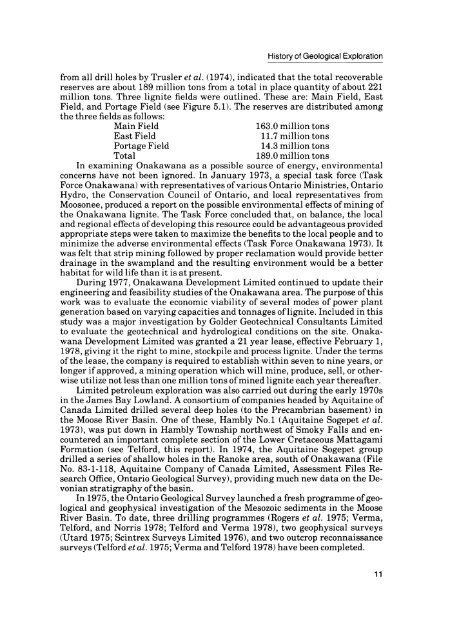Moose River Basin: geology and mineral potential - Geology Ontario
Moose River Basin: geology and mineral potential - Geology Ontario
Moose River Basin: geology and mineral potential - Geology Ontario
Create successful ePaper yourself
Turn your PDF publications into a flip-book with our unique Google optimized e-Paper software.
History of Geological Exploration<br />
from all drill holes by Trusler et al. (1974), indicated that the total recoverable<br />
reserves are about 189 million tons from a total in place quantity of about 221<br />
million tons. Three lignite fields were outlined. These are: Main Field, East<br />
Field, <strong>and</strong> Portage Field (see Figure 5.1). The reserves are distributed among<br />
the three fields as follows:<br />
Main Field<br />
163.0 million tons<br />
East Field<br />
11.7 million tons<br />
Portage Field<br />
14.3 million tons<br />
Total<br />
189.0 million tons<br />
In examining Onakawana as a possible source of energy, environmental<br />
concerns have not been ignored. In January 1973, a special task force (Task<br />
Force Onakawana) with representatives of various <strong>Ontario</strong> Ministries, <strong>Ontario</strong><br />
Hydro, the Conservation Council of <strong>Ontario</strong>, <strong>and</strong> local representatives from<br />
Moosonee, produced a report on the possible environmental effects of mining of<br />
the Onakawana lignite. The Task Force concluded that, on balance, the local<br />
<strong>and</strong> regional effects of developing this resource could be advantageous provided<br />
appropriate steps were taken to maximize the benefits to the local people <strong>and</strong> to<br />
minimize the adverse environmental effects (Task Force Onakawana 1973). It<br />
was felt that strip mining followed by proper reclamation would provide better<br />
drainage in the swampl<strong>and</strong> <strong>and</strong> the resulting environment would be a better<br />
habitat for wild life than it is at present.<br />
During 1977, Onakawana Development Limited continued to update their<br />
engineering <strong>and</strong> feasibility studies of the Onakawana area. The purpose of this<br />
work was to evaluate the economic viability of several modes of power plant<br />
generation based on varying capacities <strong>and</strong> tonnages of lignite. Included in this<br />
study was a major investigation by Golder Geotechnical Consultants Limited<br />
to evaluate the geotechnical <strong>and</strong> hydrological conditions on the site. Onaka<br />
wana Development Limited was granted a 21 year lease, effective February l,<br />
1978, giving it the right to mine, stockpile <strong>and</strong> process lignite. Under the terms<br />
of the lease, the company is required to establish within seven to nine years, or<br />
longer if approved, a mining operation which will mine, produce, sell, or other<br />
wise utilize not less than one million tons of mined lignite each year thereafter.<br />
Limited petroleum exploration was also carried out during the early 1970s<br />
in the James Bay Lowl<strong>and</strong>. A consortium of companies headed by Aquitaine of<br />
Canada Limited drilled several deep holes (to the Precambrian basement) in<br />
the <strong>Moose</strong> <strong>River</strong> <strong>Basin</strong>. One of these, Hambly No.l (Aquitaine Sogepet et al.<br />
1973), was put down in Hambly Township northwest of Smoky Falls <strong>and</strong> en<br />
countered an important complete section of the Lower Cretaceous Mattagami<br />
Formation (see Telford, this report). In 1974, the Aquitaine Sogepet group<br />
drilled a series of shallow holes in the Ranoke area, south of Onakawana (File<br />
No. 83-1-118, Aquitaine Company of Canada Limited, Assessment Files Re<br />
search Office, <strong>Ontario</strong> Geological Survey), providing much new data on the De<br />
vonian stratigraphy of the basin.<br />
In 1975, the <strong>Ontario</strong> Geological Survey launched a fresh programme of geo<br />
logical <strong>and</strong> geophysical investigation of the Mesozoic sediments in the <strong>Moose</strong><br />
<strong>River</strong> <strong>Basin</strong>. To date, three drilling programmes (Rogers et al. 1975; Verma,<br />
Telford, <strong>and</strong> Norris 1978; Telford <strong>and</strong> Verma 1978), two geophysical surveys<br />
(Utard 1975; Scintrex Surveys Limited 1976), <strong>and</strong> two outcrop reconnaissance<br />
surveys (Telford et al. 1975; Verma <strong>and</strong> Telford 1978) have been completed.<br />
11

















